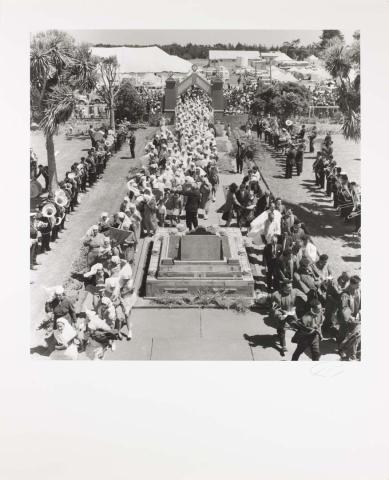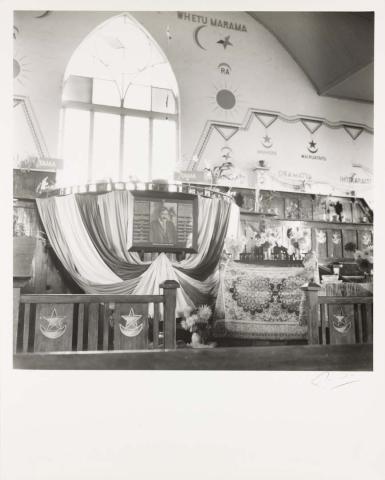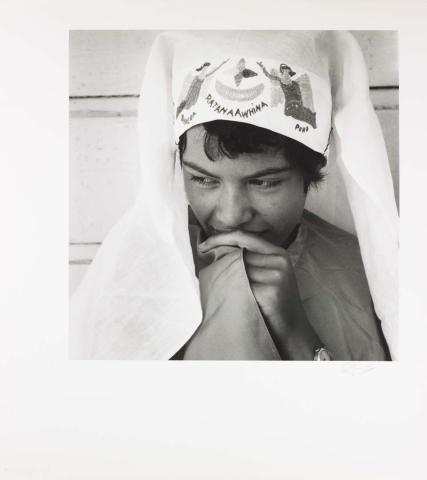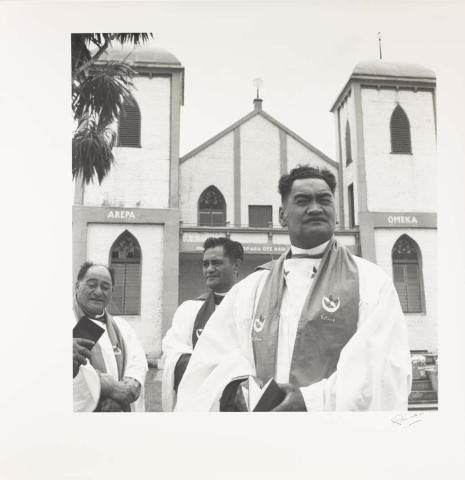WESTRA, Ans; Ruatoria
For over 50 years, Dutch-born photographer Ans Westra has been absorbed by the documentation of Maori communities in Aotearoa New Zealand. Her often frank photographic portraits have elicited varied responses, ranging from great acclaim to the censorship of the ‘Washday at the Pa’ series in the mid 1960s, to the appropriation of one of her images by leading New Zealand artist Michael Parekowhai for the Collection work What’s the time Mr Woolf 2005. Looking at these photographs, it is obvious that they are more than mere documents. Superbly composed and realised, Westra’s works resonate with a deep feeling for her subjects, their culture and, more importantly, their future. Along with many Maori elders, Westra pictures the foundation for this future involving an ongoing connection to land, family and culture, even when individuals move to cities, work alongside Pakeha (non-Maori New Zealanders) and other people from other communities, and pursue aspirations unrelated to Maoritanga(1).
The Gallery recently acquired 12 of Westra’s photographs, from two important series from the 1960s. The ‘Ruatoria’ series was created in 1963 in the format of a children’s photo story book for the New Zealand Department of Education. Written and illustrated by Westra, the book was titled Washday at the Pa and portrayed a day in the life of a Maori family with nine children, who lived in a cottage on the rural outskirts of ‘Taihape’ (the name of a town in the ’cold and snowy moutains’ of New Zealand's volcanic plateau that Westra gave to Ruatoria in order to protect the family and heighten the picturesque in the story). These beautiful images record family routines, including washing and baking bread, as well as childhood escapades - smoking Mintie wrappers, trips down to the river, and warming cold feet on the rustic wood stove before bed. Shortly after its release to schools, however, the Maori Women’s Welfare League objected to the book on the grounds that ‘The living conditions shown are not typical of Maori life’,(2) and it was withdrawn by the Department of Education.
The withdrawal of Washday at the Pa was one of the first examples of censorship in New Zealand and, as can be imagined, it generated intense debate. Today, two stories accompany Washday at the Pa: the children’s tale written by Westra about the Wereta family; and a history of responses to the ‘Ruatoria’ photographs, republished for public distribution later in 1964 by Caxton Press. As Mark Amery observes in his 2011 essay on the series, ‘these photographs . . . have been a lightning rod for discussion about how society - and in particular, Maori - are represented through photography’.(3) These debates persist today around the world, as European constructs of the life and culture of indigenous peoples continue to be challenged, particularly by new generations of indigenous artists taking up the camera themselves.
Speaking directly to the ‘Ruatoria’ photographs is a group of images documenting events at the Maori church Ratana Pa in Whanganui. Westra was initially commissioned to photograph events at Ratana Pa by the Maori magazine Te Ao Hou in 1963. The subsequent body of images, built up over 50 years, engages with expressions of the Ratana faith, founded in the 1920s by faith-healer and seer WT Ratana, whose political activism achieved significant social and welfare outcomes for Maori people. Ans Westra’s portraits of the annual 25 January pilgrimage celebrations, as well as more regular gatherings of the Ratana faithful, provide moving insights into the role that this church played within individual lives as well as documenting a movement and a time.
Ruth McDougall, Artlines no.2, 2014, p.40.
1 The qualities inherent in being a Maori, relating to heritage or culture.
2 Mrs J Eta, Ngatiporou District Council in Publishers note, 'Washday at the Pa', Caxton Press, Christchurch, 1964, p.2.
3 Mark Amery, Washday at the Pa, Suite Publishing, Wellington, 2011, p.2.
Connected objects

Ruatoria 1963, printed 1999
- WESTRA, Ans - Creator

Ruatoria 1963, printed 1999
- WESTRA, Ans - Creator

Ruatoria 1963, printed 2012
- WESTRA, Ans - Creator

Ruatoria 1963, printed mid 1980s
- WESTRA, Ans - Creator

Ruatoria 1963, printed 1999
- WESTRA, Ans - Creator

Ruatoria 1963, printed 1999
- WESTRA, Ans - Creator




